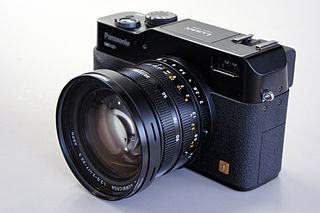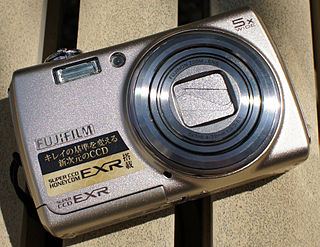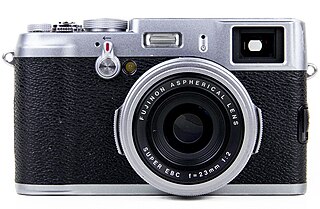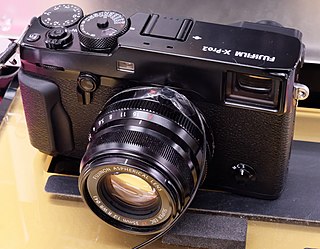
A digital camera, also called a digicam, is a camera that captures photographs in digital memory. Most cameras produced today are digital, largely replacing those that capture images on photographic film or film stock. Digital cameras are now widely incorporated into mobile devices like smartphones with the same or more capabilities and features of dedicated cameras. High-end, high-definition dedicated cameras are still commonly used by professionals and those who desire to take higher-quality photographs.

A point-and-shoot camera, also known as a compact camera and sometimes abbreviated to P&S, is a still camera designed primarily for simple operation. Most use focus free lenses or autofocus for focusing, automatic systems for setting the exposure options, and have flash units built in. They are popular for vernacular photography by people who do not consider themselves photographers but want easy-to-use cameras for snapshots of vacations, parties, reunions and other events.

A digital single-lens reflex camera is a digital camera that combines the optics and mechanisms of a single-lens reflex camera with a solid-state image sensor and digitally records the images from the sensor.
Super CCD is a proprietary charge-coupled device image sensor design that was developed by Fujifilm starting in 1999 and marketed with its digital cameras, starting with the FinePix 4700 and S1 Pro. Super CCD cameras were sold until 2010. The Super CCD uses octagonal, rather than rectangular, pixels. This allows a higher horizontal and vertical resolution to be achieved compared to a traditional sensor of an equivalent pixel count.

Advanced Photo System type-C (APS-C) is an image sensor format approximately equivalent in size to the Advanced Photo System film negative in its C ("Classic") format, of 25.1×16.7 mm, an aspect ratio of 3:2 and Ø 30.15 mm field diameter. It is therefore also equivalent in size to the Super 35 motion picture film format, which has the dimensions of 24.89 mm × 18.66 mm and Ø 31.11 mm field diameter.

Lumix is Panasonic's brand of digital cameras, ranging from pocket point-and-shoot models to digital SLRs.

A bridge camera is a type of camera that fills the niche between relatively simple point-and-shoot cameras and interchangeable-lens cameras such as mirrorless cameras and single-lens reflex cameras (SLRs). They are often comparable in size and weight to the smallest digital SLRs (DSLR), but lack interchangeable lenses, and almost all digital bridge cameras lack an optical viewfinder system. The phrase "bridge camera" has been in use at least since the 1980s, and continues to be used with digital cameras. The term was originally used to refer to film cameras which "bridged the gap" between point-and-shoot cameras and SLRs.

The FujifilmFinePix F series is a line of compact digital cameras that was known for its low-light performance in 2005, with relatively low image noise and natural colors even at high ISO settings. With its relatively large, but moderate resolution Super CCD sensors, it concentrated on image quality, and low-light shooting without flash, which was mostly restricted to prosumer models at the time.

The Fujifilm FinePix S3 Pro is an interchangeable lens digital single-lens reflex camera introduced in February 2004. Its successor, the Finepix S5 Pro, was released on 25 September 2006. It is based on a Nikon F80 viewfinder, shutter, mirror-box and autofocus modules surrounded by a Fujifilm body that includes its own proprietary CCD image sensor and electronics, and a vertical grip shutter release. It has a Nikon F lens mount and can use most lenses made for 35 mm Nikon SLR cameras, but only with manual operation with Nikon AIS lenses, unusually for a digital SLR the S3 Pro can be used with a manual cable release.

The Fujifilm FinePix S6500fd, known in the United States as S6000fd, was the first digital camera from Fujifilm with face detection technology. Also this camera has a different lens from its recent predecessors — a 28–300 mm equivalent 10.7x zoom, the same as the FinePix S9100/9600. The camera was announced on July 13, 2006.
The Fujifilm FinePix Z-series of digital cameras consists of the company's ultra-slim and lightweight point-and-shoot digital cameras. All Z-series cameras feature non-protruding folded optic design lenses and sliding lens covers, excluding the waterproof Z33WP, which has no lens cover. The w early Z-series cameras featured Fujifilm's Super CCD sensor, while later ones use other CCD sensors. Some newer models such as, the Z700EXR, Z800EXR, Z900EXR, Z950EXR, Z1000EXR and Z2000EXR, use the EXR-CMOS sensors.

A back-illuminated (BI) sensor, also known as back-side illumination (BSI) sensor, is a type of digital image sensor that uses a novel arrangement of the imaging elements to increase the amount of light captured and thereby improve low-light performance.

The FinePix IS Pro is a digital single lens reflex camera introduced by Fujifilm in 2007. It is based on a FinePix S5 Pro, which is in turn based on the Nikon D200. It has a Nikon F lens mount and can use most lenses made for 35 mm Nikon SLR cameras. It replaces the Fujifilm FinePix S3 Pro UVIR.

The Fujifilm X series is a line of digital cameras produced by Fujifilm. The series encompasses fixed lens and interchangeable lens mirrorless cameras and premium compact point-and-shoot cameras aimed at consumer, enthusiast and professional photographers. The X series is part of the larger FinePix range of digital cameras from Fujifilm.

The Fujifilm X-Pro1 is a mirrorless interchangeable-lens digital camera announced in January 2012 and launched in March 2012. It is part of Fujifilm's X-Series of cameras. In October 2012 Fujifilm released a very similar, yet smaller, camera named the X-E1. In January 2016 Fujifilm announced its successor, the X-Pro2.

The Fujifilm FinePix XP-series of digital cameras consists of the company's tough, waterproof and lightweight point-and-shoot digital cameras. All XP-series cameras feature some degree of waterproofing and shockproofing which varies from model to model. The range began in 2009 with the launch of the Fujifilm FinePix XP10. A few of the models also incorporate in-built GPS tagging.

The Fujifilm X100 is a series of digital compact cameras with a fixed prime lens. Originally part of the FinePix line, then becoming a member of the X series from Fujifilm, the X100 series includes the FinePix X100, X100S, X100T, X100F, X100V, and X100VI. They each have a large image sensor and a 23 mm lens. All six cameras have received generally positive reviews.

The Fujifilm X-Pro2 is a mirrorless interchangeable-lens digital camera announced in January 2016. It is part of Fujifilm's X-Series of cameras, the successor to the X-Pro1. Sales began on 3 March 2016.

The Fujifilm X-T3 is a mirrorless interchangeable-lens digital camera announced on September 6, 2018. It is weather-resistant, has a backside-illuminated X-Trans CMOS 4 APS-C sensor and an X-Processor 4 quad core processor. It is the successor to 2016's Fujifilm X-T2. It uses the Fujifilm X-mount.























